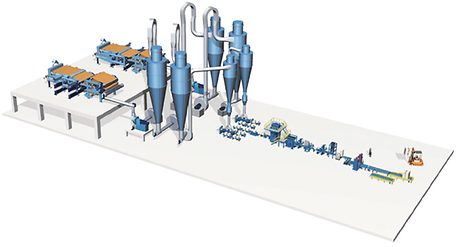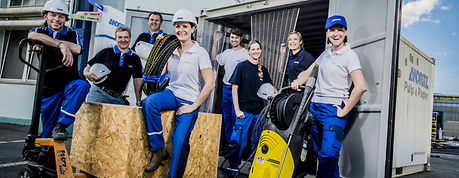Optimization, data analysis, augmented reality
Technology for pulp flash drying plants
ANDRITZ supplies single equipment for pulp flash drying lines, as well as turnkey plants.
A market pulp flash drying plant usually starts at the high density storage tower directly after the bleaching plant of the fiberline.
The pulp flash drying plant comprises screening/cleaning, dewatering, fluffing, drying, baling, and finishing operations.
Applications
Mechanical pulp and secondary fiber
Flash drying is the main method of producing dried pulp in high-capacity plants. The pulp web for these fibers is not strong enough for a sheet drying process.
Chemical pulp
Flash drying is typically used in integrated mills where the excess pulp is dried and sold as market pulp. In general, the investment costs for flash drying systems are much lower than for a sheet drying plant.
ANDRITZ pulp flash drying
Pulp screening/cleaning
Modern pulp flash drying plants are equipped with a screening/cleaning system in order to achieve high pulp cleanliness.

Pulp flash drying system
Pulp dewatering: ANDRITZ Twin Wire Press
The main advantages of using Twin Wire technology are low thermal energy consumption of the flash dryer itself (thanks to maximum dry content coming out of the press) and easy re-pulping due to gentle dewatering. Further advantages include:
- Compact design
- Minimum moving parts
- High throughput
- Excellent filtrate quality
- Reliable, fully automatic operation
- Proven in nearly 600 installations worldwide
Fluffer
The ANDRITZ fluffer (high-consistency mixer) is successfully applied in over 100 installations. The machine is designed for fluffing of the pulp particles in order to obtain a large accessible fiber surface while keeping the other fiber characteristics unchanged.
Before entering the flash dryer, the pulp must be properly distributed and fluffed. This ensures the best possible heat and water transmission between the hot drying air and the wet pulp. Fluffing is performed in two stages:
1) A spike roll shreds the pulp mat after the Twin Wire Press into small particles.
2) The pulp is then fed into a refiner-type machine where it is fluffed between a rotating disc and a static plate with special patterns.
ANDRITZ flash dryer
The pulp suspension is first dewatered with an ANDRITZ Twin Wire Press to a dryness of up to approximately 50%. The pulp is then fluffed into small pieces and dropped into the flash dryer where it is pneumatically transported by hot air while being dried. The flash dryer has up to three drying stages. Recirculation of the drying air minimizes energy consumption. For low particulate emissions, a combination of high-efficiency cyclones and a secondary scrubber can be used.
ANDRITZ slab press
The slab press compacts the pulp fluffs from the flash dryer into bales. Each bale consists of two slabs. The portion of pulp for each slab is calculated according to the respective production of the dewatering machine. Advantages include:
- Highest capacity – up to 500 t/d in a single line
- Constant bale weight
- Highly reliable
Pulp baling/bale finishing
ANDRITZ has successfully further developed state-of-the-art pulp baling technologies by revising the design and technical features to provide customers with sophisticated and reliable systems. Pulp baling lines include bale handling and wrapping of dried market pulp, such as:
- Pulp baling line (e.g. conveyor system, bale scale, bale press, wrapping machine, end folder, stenciler, bar code printer, stacker)
- Tying equipment (e.g. bale binder, unit binder)
- BaleMatic pulp baling and finishing control system
Automation
ANDRITZ has its own automation department that is capable of supplying the systems for monitoring and controlling a complete drying line.
Upgrades, rebuilds, and services
ANDRITZ has completed numerous successful projects of upgrades and rebuilds. We assist already in the early stages of a project by performing plant surveys, upgrade studies, and pilot plant trials.




